Strawberry IPM Newsletter No. 2- May 27, 2022
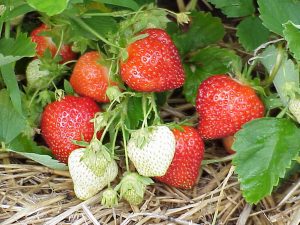
Strawberry IPM Newsletter No. 2- May 27, 2022
Click on photos to enlarge
TWO-SPOTTED SPIDER MITES ARE FOUND IN MANY FIELDS
Strawberry Clippers and Tarnished Plant Bug Numbers Low in Most fields
Spring Twilight Meeting on Tuesday, June 7, at 6 pm at Bell’s Farm, 1552 Riverside Drive in Auburn
Situation:
Warm weather has kept strawberry fields advancing at a rapid pace. Southern fields that had rowcovers this spring are starting to show a few red fruits, while later, straw-mulched fields are coming into bloom. In general, the fields we have visited look very good and the crop potential is high. Pest numbers have started to rise this week, and early bloom to petal fall is a critical time for monitoring the pest situation in your field.
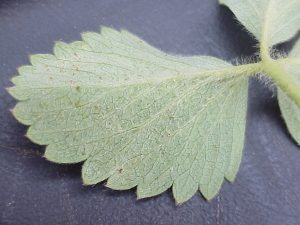
Two-spotted spider mites:
We continue to find mites in most of the fields we’ve scouted this week. Populations have been very high in some cases, and the warm, dry weather will encourage them to reproduce and spread rapidly. Start scouting for mites now, if you haven’t already. To scout for mites, collect 60 leaves from various locations in the field and examine the undersides for the presence of mites. If more than 15 leaves out of 60 sampled have any mites (25% infestation) a control should be applied. Chemical control options for two-spotted spider mites include Acramite®, Portal®, Nealta® Savey®, Zeal®, Vendex®, Oberon®, Brigade®, Danitol® and JMS Stylet Oil® (oils will cause plant injury if used in combination with captan or within 14 days of an application of sulfur).
Strawberry bud weevil:
We have found some clipped buds in fields this week, with one field in Dresden over the control threshold of 1.2 clipped buds per 2 feet of row. For much of the state, early varieties are already beyond the flowering stage when clippers can cause significant damage. Expect clipper damage to be most common in later blooming varieties now beginning to flower. Insecticide options for clippers include Lorsban®, Brigade®, Bifenture®, Danitol®, Sevin®, and PyGanic®.
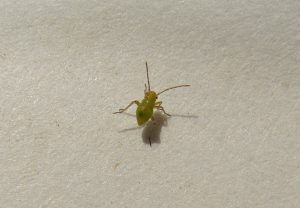
Tarnished plant bug activity has also increased slightly this week, with both adult and nymph stages present in some fields, but only one field over the control threshold of 4 or more flower clusters infested per 30 sampled. Nymphs are very still very small at this time (2 mm); look for active, yellow-green insects by tapping flower clusters over a dish. It is important to scout often, as they may appear very quickly in warm, dry weather. Insecticide options for tarnished plant bugs include malathion, Assail®, Brigade®, Bifenture®, Dibrom®, Danitol®, and PyGanic®.
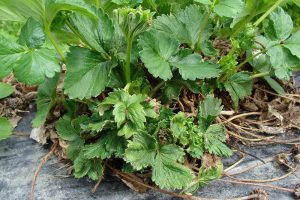
Cyclamen mites:
I have seen some evidence of cyclamen mite injury in fields this spring. Plants showing weak growth and yellow, pinkish or blackened, crinkled leaves may be infested. These mites are very small, smaller than spider mites, and reside in the crown of the strawberry plant feeding on the developing leaves and flower buds. They are very hard to see, even with magnification. Infested plants have: shrunken distorted leaves and flower stalks, and produce few to no marketable fruit. I find them most frequently in 2 and 3-year-old beds. The miticide Portal® can be effective but must be applied in lots of water and a spreader adjuvant to be sure that the material is carried down into the crowns where these mites reside. Often, miticides applications are more effective during a renovation after the leaves have been mowed off, to better get the sprays down into the crowns.
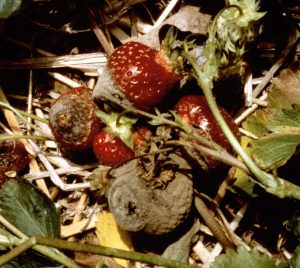
Diseases:
As more fields come into bloom protecting blossoms from gray mold (Botrytis) infection is critical. Two to three sprays of fungicide during bloom are typically required to provide good protection against this disease. Fruit infections take place almost exclusively through the flowers, so gray mold control efforts must be focused on the bloom period. If the bloom period continues to be dry and good fungicide coverage is maintained, the incidence of gray mold at harvest should be low.
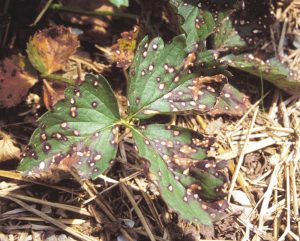
Leaf spot is a fungal disease characterized by small purple spots with white centers on the leaves. The symptoms are often first visible on the older, lower leaves. I’ve seen some leaf spot in fields scouted this spring. If you see leaf spot in your field, you should consider using a fungicide that will provide control as part of your spray program for gray mold. Products such as Captan®, Luna Sensation®, Mervion® and Pristine® have activity on both diseases.
Leather rot (Phytopthora cactorum) can become a problem in fields where standing water is common during bloom and fruit development, especially if the fields were not mulched last fall. Incidence of leather rot can be reduced by applying straw mulch between the rows to prevent berries from touching the soil and reducing soil splashing onto the berries. Foliar sprays of Aliette®, Prophyt® or Phostrol® may be applied during bloom and fruit development to prevent leather rot.
Deer:
Feeding damage by deer has been observed in several fields this spring. Rows of plants look weak or dead and have few, if any leaves, although the root system may look healthy. When deer feed on plants during the winter the plants often die, as they are exposed and the crowns are damaged. By the time the mulch is removed, the plants will just look dead, and any evidence left by the deer has been washed away. Deer will also feed in the spring, eating leaves and sometimes damaging crowns. If deer are a problem in your area, it is best to fence in the planting area before they start feeding in it. Temporary electric fences are usually adequate if set up correctly and in a timely manner. Always contact your local game warden before you consider dispatching any offending animals.
Spring Growers’ Twilight Meeting
The Maine Vegetable & Small Fruit Growers Association will be having a Spring Twilight Meeting on Tuesday, June 7, at 6 pm at Bell’s Farm, 1552 Riverside Drive in Auburn. The Dave and Ray Bell specialize in potatoes and sweet corn, but also grow a wide variety of vegetables for their stand. They supply many large groceries in the area and have a sophisticated packing line for their fresh corn. We will also have Glen Koehler from the Pest Management Office at the meeting to discuss recent concerns about PFAS chemicals in pesticides on what this means to growers in Maine.
2022-2023 New England Small Fruit Management Guides The latest edition of the Guide is available online
A printed version of the guide is now available through our office. The cost of the Guide is $25, including shipping. You can request a copy by sending a check made out to “UMaine Cooperative Extension” to the Highmoor Farm address below. Members of the Maine Vegetable & Small Fruit Growers Association will receive a copy as a benefit of membership.
You can get quick access to strawberry IPM information through the UMaine Highmoor Farm news blog
or the UMaine Pest Management web page. If you have questions about the Newsletter, please give us a call at 933.2100 or send an e-mail message to me at:
Sincerely,
David T. Handley
Vegetable & Small Fruit Specialist
Highmoor Farm Pest Management Unit
P.O. Box 179 17 Godfrey Dr.
Monmouth, ME 04259 Orono, ME 04473
207.933.2100 1.800.287.0279
Where brand names or company names are used, it is for the reader’s information. No endorsement is implied nor is any discrimination intended against products with similar ingredients. Always consult product labels for rates, application instructions and safety precautions. Users of these producers assume all associated risks.
The University of Maine is an equal opportunity/affirmative action institution.
